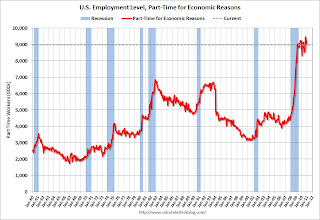by Calculated Risk on 12/03/2010 10:04:00 AM
Friday, December 03, 2010
Employment Summary and Part Time Workers, Unemployed over 26 Weeks
Here are a few more graphs based on the weak employment report ...
Percent Job Losses During Recessions
 Click on graph for larger image.
Click on graph for larger image.
This graph shows the job losses from the start of the employment recession, in percentage terms - this time from the start of the recession.
In the previous post, the graph showed the job losses aligned at the bottom.
The dotted line shows payroll employment excluding temporary Census workers.
This is by far the worst post WWII employment recession.
Part Time for Economic Reasons
 From the BLS report:
From the BLS report:
The number of persons employed part time for economic reasons (sometimes referred to as involuntary part-time workers) was little changed over the month at 9.0 million. These individuals were working part time because their hours had been cut back or because they were unable to find a full-time job.The number of workers only able to find part time jobs (or have had their hours cut for economic reasons) declined slightly to 8.972 million in November. This has been around 9 million since August 2009 - a very high level.
These workers are included in the alternate measure of labor underutilization (U-6) that was steady at 17.0% in November. The high for U-6 was 17.4% in October 2009. Still very grim.
Unemployed over 26 Weeks
 This graph shows the number of workers unemployed for 27 weeks or more.
This graph shows the number of workers unemployed for 27 weeks or more. According to the BLS, there are 6.313 million workers who have been unemployed for more than 26 weeks and still want a job. This was up from 6.206 million in October. It appears the number of long term unemployed has peaked, however the level is extremely high - and the increases over the last two months is very concerning.
Summary
Perhaps the worst news was the jump in the unemployment rate to 9.8% without an increase in the participation rate. If the participation rate had increased, at least that would mean people were becoming more confident and rejoining the labor force. Instead the Labor Force Participation Rate was flat at 64.5% and this is a very low level. Note: This is the percentage of the working age population in the labor force (here is the graph in the galleries of the participation rate).
Most of the underlying details of the employment report were weak. The positives included small upward revisions to the September and October payroll reports, a slight increase in average hourly earnings, and a slight decline in part time workers.
The negatives include the unemployment rate increasing to 9.8%, few payroll jobs added (only 39,000 jobs), the decline in the employment-population ratio, the steady participation rate at a very low level, and the increase in workers unemployed for over 26 weeks.
• Earlier Employment post: November Employment Report: 39,000 Jobs, 9.8% Unemployment Rate


